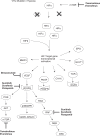Rationale for targeted therapies and potential role of pazopanib in advanced renal cell carcinoma
- PMID: 20714356
- PMCID: PMC2921256
- DOI: 10.2147/btt.s7818
Rationale for targeted therapies and potential role of pazopanib in advanced renal cell carcinoma
Abstract
Advanced renal cell carcinoma (RCC) remains a challenging, major health problem. Recent advances in understanding the fundamental biology underlying one form of RCC, ie, clear cell (or conventional) RCC, have opened the door to a series of targeted agents, such as the tyrosine kinase inhibitors (TKIs), which have become the standard of care in managing advanced clear cell RCC. Among the newest of these agents to receive Food and Drug Administration approval in this disease is pazopanib. This review will summarize what is known about the fundamental biology that underlies clear cell RCC, the data surrounding the previously approved targeted agents for this disease, including not only the TKIs but also the mTOR inhibitors and the vascular endothelial growth factor-specific agent, bevacizumab, and the newest TKI, pazopanib. It will also explore the potential role for pazopanib relative to the other available agents and where it may fit into the armamentarium for treatment of advanced/metastatic RCC.
Keywords: clear cell renal cell carcinoma; pazopanib; targeted therapy; tyrosine kinase inhibitor.
Figures

Similar articles
-
Pazopanib: an orally administered multi-targeted tyrosine kinase inhibitor for locally advanced or metastatic renal cell carcinoma.Can J Urol. 2011 Dec;18(6):5991-7. Can J Urol. 2011. PMID: 22166325 Review.
-
Critical appraisal of pazopanib as treatment for patients with advanced metastatic renal cell carcinoma.Cancer Manag Res. 2011;3:273-85. doi: 10.2147/CMR.S15557. Epub 2011 Aug 10. Cancer Manag Res. 2011. PMID: 21931501 Free PMC article.
-
Tyrosine kinase inhibitors in the treatment of advanced renal cell carcinoma: focus on pazopanib.Clin Med Insights Oncol. 2011;5:333-42. doi: 10.4137/CMO.S7263. Epub 2011 Oct 31. Clin Med Insights Oncol. 2011. PMID: 22084622 Free PMC article.
-
The prospects of pazopanib in advanced renal cell carcinoma.Ther Adv Urol. 2013 Oct;5(5):223-32. doi: 10.1177/1756287213495099. Ther Adv Urol. 2013. PMID: 24082917 Free PMC article.
-
[Recent advancements in the treatment of renal cell carcinoma--focus on international guidelines].Magy Onkol. 2010 Dec;54(4):369-76. doi: 10.1556/MOnkol.54.2010.4.11. Magy Onkol. 2010. PMID: 21163768 Review. Hungarian.
References
-
- Jemal A, Siegel R, Ward E, Hao Y, Xu J, Thun MJ. Cancer statistics. CA Cancer J Clin. 2009;59(4):225–249. - PubMed
-
- Chow WH, Devesa SS, Warren JL, Fraumeni JF., Jr Rising incidence of renal cell cancer in the United States. JAMA. 1999;281(17):1628–1631. - PubMed
-
- Mevorach RA, Segal AJ, Tersegno ME, Frank IN. Renal cell carcinoma: Incidental diagnosis and natural history; review of 235 cases. Urology. 1992;39(6):519–522. - PubMed
-
- Bukowski RM. Cytokine therapy for metastatic renal cell carcinoma. Semin Urol Oncol. 2001;19(2):148–154. - PubMed
-
- Motzer RJ, Russo P. Systemic therapy for renal cell carcinoma. J Urol. 2000;163(2):408–417. - PubMed
Grants and funding
LinkOut - more resources
Full Text Sources
Other Literature Sources
Miscellaneous

